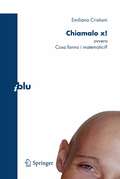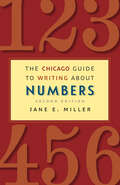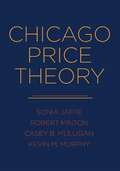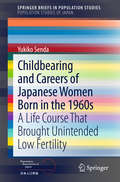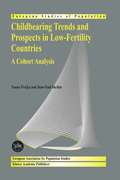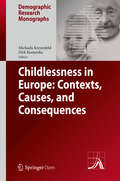- Table View
- List View
Chi-squared Goodness-of-fit Tests for Censored Data
by Mikhail S. Nikulin Ekaterina V. ChimitovaThis book is devoted to the problems of construction and application of chi-squared goodness-of-fit tests for complete and censored data. Classical chi-squared tests assume that unknown distribution parameters are estimated using grouped data, but in practice this assumption is often forgotten. In this book, we consider modified chi-squared tests, which do not suffer from such a drawback. The authors provide examples of chi-squared tests for various distributions widely used in practice, and also consider chi-squared tests for the parametric proportional hazards model and accelerated failure time model, which are widely used in reliability and survival analysis. Particular attention is paid to the choice of grouping intervals and simulations. This book covers recent innovations in the field as well as important results previously only published in Russian. Chi-squared tests are compared with other goodness-of-fit tests (such as the Cramer-von Mises-Smirnov, Anderson-Darling and Zhang tests) in terms of power when testing close competing hypotheses.
Chi-squared Goodness-of-fit Tests for Censored Data
by Mikhail S. Nikulin Ekaterina V. ChimitovaThis book is devoted to the problems of construction and application of chi-squared goodness-of-fit tests for complete and censored data. Classical chi-squared tests assume that unknown distribution parameters are estimated using grouped data, but in practice this assumption is often forgotten. In this book, we consider modified chi-squared tests, which do not suffer from such a drawback. The authors provide examples of chi-squared tests for various distributions widely used in practice, and also consider chi-squared tests for the parametric proportional hazards model and accelerated failure time model, which are widely used in reliability and survival analysis. Particular attention is paid to the choice of grouping intervals and simulations. This book covers recent innovations in the field as well as important results previously only published in Russian. Chi-squared tests are compared with other goodness-of-fit tests (such as the Cramer-von Mises-Smirnov, Anderson-Darling and Zhang tests) in terms of power when testing close competing hypotheses.
Chiamalo x!: ovvero Cosa fanno i matematici? (I blu)
by Emiliano CristianiVi siete mai chiesti cosa fa un matematico quando scrive freneticamente su un foglio di carta? Provate a chiederglielo. Vi sentirete rispondere qualcosa del tipo: "Sto cercando di dimostrare la natura iperbolica di questa equazione differenziale per poter applicare il metodo delle caratteristiche". Non avete capito? Provate a chiedergli di spiegarvelo più semplicemente. La risposta sarà: "Allora... Ecco... Come posso dire... Sto cercando di dimostrare che questo coso qui (indica un formulone) appartiene a una certa categoria di equazioni in cui la soluzione si propaga da un certo dato iniziale lungo delle curve particolari." Inutile insistere, non vi resta che andarvene. La matematica vi ha respinto un'altra volta. Ma una soluzione esiste ed è unica: leggere questo libro e lasciarvi guidare nell’incantato mondo dell'alta matematica senza per questo fare alta matematica. Capirete finalmente cosa studiano i matematici, cosa pensano, cosa li appassiona e in quale strano mondo n-dimensionale vivono. Dedicato a tutti coloro che vorrebbero studiare matematica ma che non lo hanno mai (o ancora) fatto, questo libro vi convincerà che la matematica è il perfetto connubio tra scienza e arte, tra curiosità e fantasia, tra scoperta ed invenzione.
The Chicago Guide to Writing about Multivariate Analysis, Second Edition (Chicago Guides to Writing, Editing, and Publishing)
by Jane E. MillerMany different people, from social scientists to government agencies to business professionals, depend on the results of multivariate models to inform their decisions. Researchers use these advanced statistical techniques to analyze relationships among multiple variables, such as how exercise and weight relate to the risk of heart disease, or how unemployment and interest rates affect economic growth. Yet, despite the widespread need to plainly and effectively explain the results of multivariate analyses to varied audiences, few are properly taught this critical skill. The Chicago Guide to Writing about Multivariate Analysis is the book researchers turn to when looking for guidance on how to clearly present statistical results and break through the jargon that often clouds writing about applications of statistical analysis. This new edition features even more topics and real-world examples, making it the must-have resource for anyone who needs to communicate complex research results. For this second edition, Jane E. Miller includes four new chapters that cover writing about interactions, writing about event history analysis, writing about multilevel models, and the “Goldilocks principle” for choosing the right size contrast for interpreting results for different variables. In addition, she has updated or added numerous examples, while retaining her clear voice and focus on writers thinking critically about their intended audience and objective. Online podcasts, templates, and an updated study guide will help readers apply skills from the book to their own projects and courses. This continues to be the only book that brings together all of the steps involved in communicating findings based on multivariate analysis—finding data, creating variables, estimating statistical models, calculating overall effects, organizing ideas, designing tables and charts, and writing prose—in a single volume. When aligned with Miller’s twelve fundamental principles for quantitative writing, this approach will empower readers—whether students or experienced researchers—to communicate their findings clearly and effectively.
The Chicago Guide to Writing about Multivariate Analysis, Second Edition (Chicago Guides to Writing, Editing, and Publishing)
by Jane E. MillerMany different people, from social scientists to government agencies to business professionals, depend on the results of multivariate models to inform their decisions. Researchers use these advanced statistical techniques to analyze relationships among multiple variables, such as how exercise and weight relate to the risk of heart disease, or how unemployment and interest rates affect economic growth. Yet, despite the widespread need to plainly and effectively explain the results of multivariate analyses to varied audiences, few are properly taught this critical skill. The Chicago Guide to Writing about Multivariate Analysis is the book researchers turn to when looking for guidance on how to clearly present statistical results and break through the jargon that often clouds writing about applications of statistical analysis. This new edition features even more topics and real-world examples, making it the must-have resource for anyone who needs to communicate complex research results. For this second edition, Jane E. Miller includes four new chapters that cover writing about interactions, writing about event history analysis, writing about multilevel models, and the “Goldilocks principle” for choosing the right size contrast for interpreting results for different variables. In addition, she has updated or added numerous examples, while retaining her clear voice and focus on writers thinking critically about their intended audience and objective. Online podcasts, templates, and an updated study guide will help readers apply skills from the book to their own projects and courses. This continues to be the only book that brings together all of the steps involved in communicating findings based on multivariate analysis—finding data, creating variables, estimating statistical models, calculating overall effects, organizing ideas, designing tables and charts, and writing prose—in a single volume. When aligned with Miller’s twelve fundamental principles for quantitative writing, this approach will empower readers—whether students or experienced researchers—to communicate their findings clearly and effectively.
The Chicago Guide to Writing about Multivariate Analysis, Second Edition (Chicago Guides to Writing, Editing, and Publishing)
by Jane E. MillerMany different people, from social scientists to government agencies to business professionals, depend on the results of multivariate models to inform their decisions. Researchers use these advanced statistical techniques to analyze relationships among multiple variables, such as how exercise and weight relate to the risk of heart disease, or how unemployment and interest rates affect economic growth. Yet, despite the widespread need to plainly and effectively explain the results of multivariate analyses to varied audiences, few are properly taught this critical skill. The Chicago Guide to Writing about Multivariate Analysis is the book researchers turn to when looking for guidance on how to clearly present statistical results and break through the jargon that often clouds writing about applications of statistical analysis. This new edition features even more topics and real-world examples, making it the must-have resource for anyone who needs to communicate complex research results. For this second edition, Jane E. Miller includes four new chapters that cover writing about interactions, writing about event history analysis, writing about multilevel models, and the “Goldilocks principle” for choosing the right size contrast for interpreting results for different variables. In addition, she has updated or added numerous examples, while retaining her clear voice and focus on writers thinking critically about their intended audience and objective. Online podcasts, templates, and an updated study guide will help readers apply skills from the book to their own projects and courses. This continues to be the only book that brings together all of the steps involved in communicating findings based on multivariate analysis—finding data, creating variables, estimating statistical models, calculating overall effects, organizing ideas, designing tables and charts, and writing prose—in a single volume. When aligned with Miller’s twelve fundamental principles for quantitative writing, this approach will empower readers—whether students or experienced researchers—to communicate their findings clearly and effectively.
The Chicago Guide to Writing about Numbers, Second Edition (Chicago Guides to Writing, Editing, and Publishing)
by Jane E. MillerEarning praise from scientists, journalists, faculty, and students, The Chicago Guide to Writing about Numbers has helped thousands of writers communicate data clearly and effectively. Its publication offered a much-needed bridge between good quantitative analysis and clear expository writing, using straightforward principles and efficient prose. With this new edition, Jane Miller draws on a decade of additional experience and research, expanding her advice on reaching everyday audiences and further integrating non-print formats. Miller, an experienced teacher of research methods, statistics, and research writing, opens by introducing a set of basic principles for writing about numbers, then presents a toolkit of techniques that can be applied to prose, tables, charts, and presentations. Throughout the book, she emphasizes flexibility, showing writers that different approaches work for different kinds of data and different types of audiences. The second edition adds a chapter on writing about numbers for lay audiences, explaining how to avoid overwhelming readers with jargon and technical issues. Also new is an appendix comparing the contents and formats of speeches, research posters, and papers, to teach writers how to create all three types of communication without starting each from scratch. An expanded companion website includes new multimedia resources such as slide shows and podcasts that illustrate the concepts and techniques, along with an updated study guide of problem sets and suggested course extensions. This continues to be the only book that brings together all the tasks that go into writing about numbers, integrating advice on finding data, calculating statistics, organizing ideas, designing tables and charts, and writing prose all in one volume. Field-tested with students and professionals alike, this holistic book is the go-to guide for everyone who writes or speaks about numbers.
The Chicago Guide to Writing about Numbers, Second Edition (Chicago Guides to Writing, Editing, and Publishing)
by Jane E. MillerEarning praise from scientists, journalists, faculty, and students, The Chicago Guide to Writing about Numbers has helped thousands of writers communicate data clearly and effectively. Its publication offered a much-needed bridge between good quantitative analysis and clear expository writing, using straightforward principles and efficient prose. With this new edition, Jane Miller draws on a decade of additional experience and research, expanding her advice on reaching everyday audiences and further integrating non-print formats. Miller, an experienced teacher of research methods, statistics, and research writing, opens by introducing a set of basic principles for writing about numbers, then presents a toolkit of techniques that can be applied to prose, tables, charts, and presentations. Throughout the book, she emphasizes flexibility, showing writers that different approaches work for different kinds of data and different types of audiences. The second edition adds a chapter on writing about numbers for lay audiences, explaining how to avoid overwhelming readers with jargon and technical issues. Also new is an appendix comparing the contents and formats of speeches, research posters, and papers, to teach writers how to create all three types of communication without starting each from scratch. An expanded companion website includes new multimedia resources such as slide shows and podcasts that illustrate the concepts and techniques, along with an updated study guide of problem sets and suggested course extensions. This continues to be the only book that brings together all the tasks that go into writing about numbers, integrating advice on finding data, calculating statistics, organizing ideas, designing tables and charts, and writing prose all in one volume. Field-tested with students and professionals alike, this holistic book is the go-to guide for everyone who writes or speaks about numbers.
The Chicago Guide to Writing about Numbers, Second Edition (Chicago Guides to Writing, Editing, and Publishing)
by Jane E. MillerEarning praise from scientists, journalists, faculty, and students, The Chicago Guide to Writing about Numbers has helped thousands of writers communicate data clearly and effectively. Its publication offered a much-needed bridge between good quantitative analysis and clear expository writing, using straightforward principles and efficient prose. With this new edition, Jane Miller draws on a decade of additional experience and research, expanding her advice on reaching everyday audiences and further integrating non-print formats. Miller, an experienced teacher of research methods, statistics, and research writing, opens by introducing a set of basic principles for writing about numbers, then presents a toolkit of techniques that can be applied to prose, tables, charts, and presentations. Throughout the book, she emphasizes flexibility, showing writers that different approaches work for different kinds of data and different types of audiences. The second edition adds a chapter on writing about numbers for lay audiences, explaining how to avoid overwhelming readers with jargon and technical issues. Also new is an appendix comparing the contents and formats of speeches, research posters, and papers, to teach writers how to create all three types of communication without starting each from scratch. An expanded companion website includes new multimedia resources such as slide shows and podcasts that illustrate the concepts and techniques, along with an updated study guide of problem sets and suggested course extensions. This continues to be the only book that brings together all the tasks that go into writing about numbers, integrating advice on finding data, calculating statistics, organizing ideas, designing tables and charts, and writing prose all in one volume. Field-tested with students and professionals alike, this holistic book is the go-to guide for everyone who writes or speaks about numbers.
The Chicago Guide to Writing about Numbers, Second Edition (Chicago Guides to Writing, Editing, and Publishing)
by Jane E. MillerEarning praise from scientists, journalists, faculty, and students, The Chicago Guide to Writing about Numbers has helped thousands of writers communicate data clearly and effectively. Its publication offered a much-needed bridge between good quantitative analysis and clear expository writing, using straightforward principles and efficient prose. With this new edition, Jane Miller draws on a decade of additional experience and research, expanding her advice on reaching everyday audiences and further integrating non-print formats. Miller, an experienced teacher of research methods, statistics, and research writing, opens by introducing a set of basic principles for writing about numbers, then presents a toolkit of techniques that can be applied to prose, tables, charts, and presentations. Throughout the book, she emphasizes flexibility, showing writers that different approaches work for different kinds of data and different types of audiences. The second edition adds a chapter on writing about numbers for lay audiences, explaining how to avoid overwhelming readers with jargon and technical issues. Also new is an appendix comparing the contents and formats of speeches, research posters, and papers, to teach writers how to create all three types of communication without starting each from scratch. An expanded companion website includes new multimedia resources such as slide shows and podcasts that illustrate the concepts and techniques, along with an updated study guide of problem sets and suggested course extensions. This continues to be the only book that brings together all the tasks that go into writing about numbers, integrating advice on finding data, calculating statistics, organizing ideas, designing tables and charts, and writing prose all in one volume. Field-tested with students and professionals alike, this holistic book is the go-to guide for everyone who writes or speaks about numbers.
The Chicago Guide to Writing about Numbers, Second Edition (Chicago Guides to Writing, Editing, and Publishing)
by Jane E. MillerEarning praise from scientists, journalists, faculty, and students, The Chicago Guide to Writing about Numbers has helped thousands of writers communicate data clearly and effectively. Its publication offered a much-needed bridge between good quantitative analysis and clear expository writing, using straightforward principles and efficient prose. With this new edition, Jane Miller draws on a decade of additional experience and research, expanding her advice on reaching everyday audiences and further integrating non-print formats. Miller, an experienced teacher of research methods, statistics, and research writing, opens by introducing a set of basic principles for writing about numbers, then presents a toolkit of techniques that can be applied to prose, tables, charts, and presentations. Throughout the book, she emphasizes flexibility, showing writers that different approaches work for different kinds of data and different types of audiences. The second edition adds a chapter on writing about numbers for lay audiences, explaining how to avoid overwhelming readers with jargon and technical issues. Also new is an appendix comparing the contents and formats of speeches, research posters, and papers, to teach writers how to create all three types of communication without starting each from scratch. An expanded companion website includes new multimedia resources such as slide shows and podcasts that illustrate the concepts and techniques, along with an updated study guide of problem sets and suggested course extensions. This continues to be the only book that brings together all the tasks that go into writing about numbers, integrating advice on finding data, calculating statistics, organizing ideas, designing tables and charts, and writing prose all in one volume. Field-tested with students and professionals alike, this holistic book is the go-to guide for everyone who writes or speaks about numbers.
The Chicago Guide to Writing about Numbers, Second Edition (Chicago Guides to Writing, Editing, and Publishing)
by Jane E. MillerEarning praise from scientists, journalists, faculty, and students, The Chicago Guide to Writing about Numbers has helped thousands of writers communicate data clearly and effectively. Its publication offered a much-needed bridge between good quantitative analysis and clear expository writing, using straightforward principles and efficient prose. With this new edition, Jane Miller draws on a decade of additional experience and research, expanding her advice on reaching everyday audiences and further integrating non-print formats. Miller, an experienced teacher of research methods, statistics, and research writing, opens by introducing a set of basic principles for writing about numbers, then presents a toolkit of techniques that can be applied to prose, tables, charts, and presentations. Throughout the book, she emphasizes flexibility, showing writers that different approaches work for different kinds of data and different types of audiences. The second edition adds a chapter on writing about numbers for lay audiences, explaining how to avoid overwhelming readers with jargon and technical issues. Also new is an appendix comparing the contents and formats of speeches, research posters, and papers, to teach writers how to create all three types of communication without starting each from scratch. An expanded companion website includes new multimedia resources such as slide shows and podcasts that illustrate the concepts and techniques, along with an updated study guide of problem sets and suggested course extensions. This continues to be the only book that brings together all the tasks that go into writing about numbers, integrating advice on finding data, calculating statistics, organizing ideas, designing tables and charts, and writing prose all in one volume. Field-tested with students and professionals alike, this holistic book is the go-to guide for everyone who writes or speaks about numbers.
Chicago Price Theory
by Sonia Jaffe Robert Minton Casey B. Mulligan Kevin M. MurphyAn authoritative textbook based on the legendary economics course taught at the University of ChicagoPrice theory is a powerful analytical toolkit for measuring, explaining, and predicting human behavior in the marketplace. This incisive textbook provides an essential introduction to the subject, offering a diverse array of practical methods that empower students to learn by doing. Based on Economics 301, the legendary PhD course taught at the University of Chicago, the book emphasizes the importance of applying price theory in order to master its concepts.Chicago Price Theory features immersive chapter-length examples such as addictive goods, urban-property pricing, the consequences of prohibition, the value of a statistical life, and occupational choice. It looks at human behavior in the aggregate of an industry, region, or demographic group, but also provides models of individuals when they offer insights about the aggregate. The book explains the surprising answers that price theory can provide to practical questions about taxation, education, the housing market, government subsidies, and much more.Emphasizes the application of price theory, enabling students to learn by doingFeatures chapter-length examples such as addictive goods, urban-property pricing, the consequences of prohibition, and the value of a statistical lifeSupported by video lectures taught by Kevin M. Murphy and Gary BeckerThe video course enables students to learn the theory at home and practice the applications in the classroom
The Chief Data Officer Management Handbook: Set Up and Run an Organization’s Data Supply Chain
by Martin TrederThere is no denying that the 21st century is data driven, with many digital industries relying on careful collection and analysis of mass volumes of information. A Chief Data Officer (CDO) at a company is the leader of this process, making the position an often daunting one. The Chief Data Officer Management Handbook is here to help.With this book, author Martin Treder advises CDOs on how to be better prepared for their swath of responsibilities, how to develop a more sustainable approach, and how to avoid the typical pitfalls. Based on positive and negative experiences shared by current CDOs, The Chief Data Officer Management Handbook guides you in designing the ideal structure of a data office, implementing it, and getting the right people on board.Important topics such as the data supply chain, data strategy, and data governance are thoughtfully covered by Treder. As a CDO it is important to use your position effectively with your entire team. The Chief Data Officer Management Handbook allows all employees to take ownership in data collaboration. Data is the foundation of present and future tech innovations, and you could be the leader that makes the next big impact.What You Will LearnApply important elements of effective data managementGain a comprehensive overview of all areas of data (which are often managed independently Work with the data supply chain, from data acquisition to its usage, a review of all relevant stakeholders, data strategy, and data governanceWho This Book is ForCDOs, data executives, data advisors, and all professionals looking to understand about how a data office functions in an organization.
Child Health and Well-being in India: Equity vs Efficiency
by Jalandhar PradhanThis book examines the state of child health and well-being in India. It traces the roots of child health inequalities in India; draws on the latest NFHS-V, 2019–21 data; and analyses various child health and nutrition indicators from the perspective of equity and efficiency. This volume addresses various contexts and methodologies available to measure health inequalities among Indian children. It also assesses the child’s well-being in terms of “Multidimensional Child Poverty”. As a policy document, this work examines and quantifies the equity and efficiency dimensions of various child health indicators among Indian states. Assessment of between- and within-group inequalities by various socio-economic groups provides new insights into addressing the issue of health inequalities among Indian children. An in-depth work on child health and development, this book will be of great interest to scholars and researchers of health and public policy, development studies, health economics, and South Asian studies. It will also be of use to NGOs, policymakers, and think-tanks in the field.
Child Health and Well-being in India: Equity vs Efficiency
by Jalandhar PradhanThis book examines the state of child health and well-being in India. It traces the roots of child health inequalities in India; draws on the latest NFHS-V, 2019–21 data; and analyses various child health and nutrition indicators from the perspective of equity and efficiency. This volume addresses various contexts and methodologies available to measure health inequalities among Indian children. It also assesses the child’s well-being in terms of “Multidimensional Child Poverty”. As a policy document, this work examines and quantifies the equity and efficiency dimensions of various child health indicators among Indian states. Assessment of between- and within-group inequalities by various socio-economic groups provides new insights into addressing the issue of health inequalities among Indian children. An in-depth work on child health and development, this book will be of great interest to scholars and researchers of health and public policy, development studies, health economics, and South Asian studies. It will also be of use to NGOs, policymakers, and think-tanks in the field.
Childbearing and Careers of Japanese Women Born in the 1960s: A Life Course That Brought Unintended Low Fertility (SpringerBriefs in Population Studies)
by Yukiko SendaThis book provides the keys to understanding the trajectory that Japanese society has followed toward its lowest-low fertility since the 1980s. The characteristics of the life course of women born in the 1960s, who were the first cohort to enter that trajectory, are explored by using both qualitative and quantitative data analyses. Among the many books explaining the decline in fertility, this book is unique in four ways. First, it describes in detail the reality of factors concerning the fertility decline in Japan. Second, the book uses both qualitative and quantitative methods to introduce the whole picture of how the low-fertility trend began in the 1980s and developed in the 1990s and thereafter. Third, the focus is on a specific birth cohort because their experiences determined the current patterns of family formation such as late marriage and postponed childbirth. Fourth, the book explores the knife-edge balance between work and family conditions, especially with regard to childbearing, in the context of Japanese management and gender norms. After examining the characteristics of demographic and socioeconomic circumstances of postwar Japan in detail, it can be seen that the change in family formation first occurred drastically in the 1960s cohort. Using both qualitative interview data cumulatively from 150 people and quantitative estimates with official statistics, this book shows how individual-level choices to balance work and family obligations resulted in a national-level fertility decline. Another focus of this book is the increasing unintended infertility due to postponed pregnancy, a phenomenon that is attracting great social attention because the average age of pregnancy is approaching the biological limit. This book is a valuable resource for researchers who are interested in the rapid fertility decline as well as the work–life balance and the life course of women in Japanese employment practice and family traditions.
Childbearing Trends and Prospects in Low-Fertility Countries: A Cohort Analysis (European Studies of Population #13)
by Tomas Frejka Jean-Paul Sardon"This is a tour de force in cohort fertility analysis, a deep and powerful piece of work. It is a striking demonstration of the force of really detailed empirical analysis of excellent and comprehensive data, with the data looked at from every angle and judiciously extrapolated into the future. It represents a major contribution to our understanding of contemporary low fertility in Europe and other developed nations..." Thomas K. Burch, University of Victoria, BC, Canada
Childlessness in Europe: Contexts, Causes, and Consequences (Demographic Research Monographs)
by Michaela Kreyenfeld Dirk KonietzkaThis book is published open access under a CC BY 4.0 license.This open access book provides an overview of childlessness throughout Europe. It offers a collection of papers written by leading demographers and sociologists that examine contexts, causes, and consequences of childlessness in countries throughout the region.The book features data from all over Europe. It specifically highlights patterns of childlessness in Germany, France, the United Kingdom, Finland, Sweden, Austria and Switzerland. An additional chapter on childlessness in the United States puts the European experience in perspective. The book offers readers such insights as the determinants of lifelong childlessness, whether governments can and should counteract increasing childlessness, how the phenomenon differs across social strata and the role economic uncertainties play. In addition, the book also examines life course dynamics and biographical patterns, assisted reproduction as well as the consequences of childlessness. Childlessness has been increasing rapidly in most European countries in recent decades. This book offers readers expert analysis into this issue from leading experts in the field of family behavior. From causes to consequences, it explores the many facets of childlessness throughout Europe to present a comprehensive portrait of this important demographic and sociological trend.
Children are Everywhere: Conspicuous Reproduction and Childlessness in Reunified Berlin (Fertility, Reproduction and Sexuality: Social and Cultural Perspectives #53)
by Meghana JoshiChildren are Everywhere engages with how demographic anxieties and reproductive regimes emerge as forms of social inclusion and exclusion in a low fertility Western European context. This book explores everyday experiences of parenting and childlessness of ‘ethnic’ Germans in Berlin, who came of age around the fall of the Berlin Wall, and brings them into conversation with theories on parenting, waithood, non-biological intimacies, and masculinities. This is the first ethnographic work by a South Asian author on demographic anxieties and reproduction in Germany and reverses the anthropological gaze to study Europe as the ‘Other.’
Children are Everywhere: Conspicuous Reproduction and Childlessness in Reunified Berlin (Fertility, Reproduction and Sexuality: Social and Cultural Perspectives #53)
by Meghana JoshiChildren are Everywhere engages with how demographic anxieties and reproductive regimes emerge as forms of social inclusion and exclusion in a low fertility Western European context. This book explores everyday experiences of parenting and childlessness of ‘ethnic’ Germans in Berlin, who came of age around the fall of the Berlin Wall, and brings them into conversation with theories on parenting, waithood, non-biological intimacies, and masculinities. This is the first ethnographic work by a South Asian author on demographic anxieties and reproduction in Germany and reverses the anthropological gaze to study Europe as the ‘Other.’
Children are Everywhere: Conspicuous Reproduction and Childlessness in Reunified Berlin (Fertility, Reproduction and Sexuality: Social and Cultural Perspectives #53)
by Meghana JoshiChildren are Everywhere engages with how demographic anxieties and reproductive regimes emerge as forms of social inclusion and exclusion in a low fertility Western European context. This book explores everyday experiences of parenting and childlessness of ‘ethnic’ Germans in Berlin, who came of age around the fall of the Berlin Wall, and brings them into conversation with theories on parenting, waithood, non-biological intimacies, and masculinities. This is the first ethnographic work by a South Asian author on demographic anxieties and reproduction in Germany and reverses the anthropological gaze to study Europe as the ‘Other.’
Children for Families or Families for Children: The Demography of Adoption Behavior in the U.S. (The Springer Series on Demographic Methods and Population Analysis #29)
by Mary Ann DavisDo adoptions provide children for families or families for children? This book analyzes the complex interactions between adopters and adoptees using historical and current data. Who are the preferred parents and children, both domestically and internationally? How do the types of adoptions-domestic adoptions, private and public through the foster care system, and intercountry adoptions-differ? Domestic trends include a shift to open adoptions and a notable increase in "hard to place", foster care adoptions-typically older, siblings, minorities, with physical, educational, or emotional challenges. Adoptive parents are increasingly all ages (including grandparents); all types of marriages (single, married and same-sex couples); all income levels, with subsidized adoptions for children who would otherwise remain in foster or institutional care. Intercountry adoptions have followed waves, pushed by wars and political or economic crises in the sending country, and pulled by the increasing demand from the U. S. Currently there is a decrease in intercountry adoptions from Asia and Eastern Europe with a possible fifth wave from Africa with the greatest number from Ethiopia. This is a resource for family sociologists, demographers, social workers, advocates for children and adoptive parents, as well as those who are interested in the continuing research in adoptions.
Children’s Creative Inquiry in STEM (Sociocultural Explorations of Science Education #25)
by Karen Janette Murcia Coral Campbell Mathilda Marie Joubert Sinead WilsonThis edited volume brings together international research that explores children’s creativity in STEM inquiry. It takes the position that creativity is relevant in all aspects of life and is essential for adaptable and innovative thinking. The research informed content of the book, highlights both challenges and opportunities for growing children’s creativity. The book focuses on fostering children’s creativity and natural curiosity in the world around them through STEM inquiry. Through STEM inquiry, children are learning through a cross- disciplinary approach where they apply concepts from multiple fields as they are thinking creatively, problem solving and constructing solutions. Educators play a critical role in encouraging children’s creativity by modelling creativity, providing creative projects for children and importantly, establishing rich culturally connected environments where children have the resources, conditions and opportunities for acting and thinking creatively. The book provides a lens for looking at children’s creativity in a range of different cultural settings. It offers insight and guidance to future research and will build educators’ capacity for developing children’s creative practices.
Children's Errors in Mathematics (Transforming Primary QTS Series)
by Alice Hansen Doreen Drews John Dudgeon Fiona Lawton Liz SurteesThis practical and popular guide to children&’s common errors and misconceptions in primary mathematics is an essential tool for teachers and trainees. It supports them in planning for and tackling potential errors and enhances their understanding of the difficulties encountered in mathematical development. Providing guidance on how to identify common misconceptions, it explores how common misconceptions can be anticipated and addressed. What's new to this edition? New introductory chapter exploring contemporary themes and approaches being used in primary classrooms and schools today, such and Singapore and Shanghai maths. More content on mastery approaches to teaching mathematics, exploring &‘what is mastery&’? Support around preparing children for new statutory times tables test with new content and a deeper exploration of children&’s errors in multiplication. More intervention strategies. New scenarios section.

